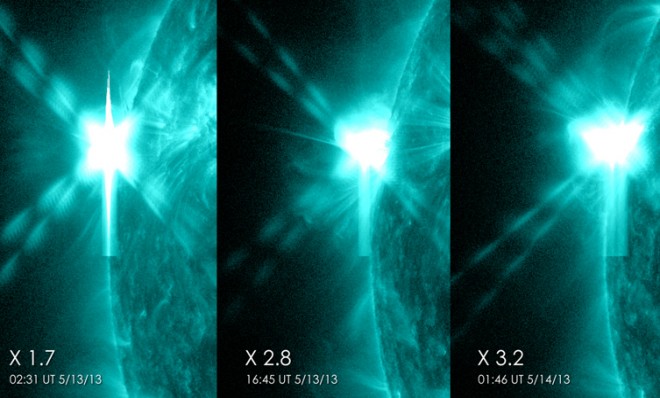4 huge solar flares in 48 hours: What's going on with the sun?
Thankfully, none of the fiery bursts are headed Earth's way

2013 has been a relatively quiet year in terms of solar activity — at least until this week. For the past two days, the sun anchoring our solar system has been throwing something of a temper tantrum. And it's made for some rather spectacular fireworks.
In the past 48 hours alone, the sun has sent four colossal X-class solar flares whipping into space, all emerging from darkened sunspots dotting our star's chromosphere. (X-class flares, it's worth noting, are assigned a number to illustrate their relative strength: An X2 flare is twice as powerful as an X1, and so forth.)
Wired reports that the first three projections were each "the most energetic solar flare of 2013" — until "the next one came along."
The Week
Escape your echo chamber. Get the facts behind the news, plus analysis from multiple perspectives.

Sign up for The Week's Free Newsletters
From our morning news briefing to a weekly Good News Newsletter, get the best of The Week delivered directly to your inbox.
From our morning news briefing to a weekly Good News Newsletter, get the best of The Week delivered directly to your inbox.
The first, an X1.7, occurred around 10 p.m. U.S. Eastern time, on May 12. Then, an X2.8 erupted at 12:05 p.m. on May 13. And the last one, an X3.2, peaked at 9:11 p.m. on May 13. X3.2 is the third-largest flare of this solar cycle, with the largest being an X6.9 in 2011. [Wired]
The fourth and decidedly more benign flare, according to BBC News, was an X1 that sprang up briefly in the middle of the night.
Alex Young, a heliophysicist at NASA, tells Wired that the flares each produced about 100 sextillion Joules of energy. For perspective, that's the rough equivalent of 100 million hydrogen bombs detonating simultaneously.
On the bright side, the sunspots weren't facing Earth, meaning the resulting solar radiation won't be disrupting any of our satellite-powered GPS or phone signals here on the ground. That's not to say a future solar eruption couldn't do damage: In one memorable example, a similar phenomenon called a coronal mass ejection — which also explodes from the sun's surface — blew through Earth's protective atmosphere back in September 1859, reportedly shorting out telegraph wires and starting fires in North America and Europe.
As for why the sun is suddenly whipping itself into a frenzy, NASA scientists say the behavior is actually quite normal. Our big, glowing ball of warmth is merely ramping up for a period of intense activity called its solar maximum, which occurs every 11 years or so. For a brief period, "there can be hundreds of sunspots" twisting and poking through the sun's photosphere, whipping around all sorts of fiery tendrils. While the last solar maximum in 2000 passed without causing too much trouble, NASA says the coming period could be the most intense since 1958.
A free daily email with the biggest news stories of the day – and the best features from TheWeek.com
(Via NASA)
-
 Quiz of The Week: 29 November – 5 December
Quiz of The Week: 29 November – 5 DecemberQuiz Have you been paying attention to The Week’s news?
-
 The week’s best photos
The week’s best photosIn Pictures A drive in the desert, prayers with pigeons, and more
-
 The Week Unwrapped: Will drought fuel global violence?
The Week Unwrapped: Will drought fuel global violence?Podcast Plus why did Trump pardon a drug-trafficking president? And are romantic comedies in terminal decline?